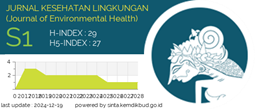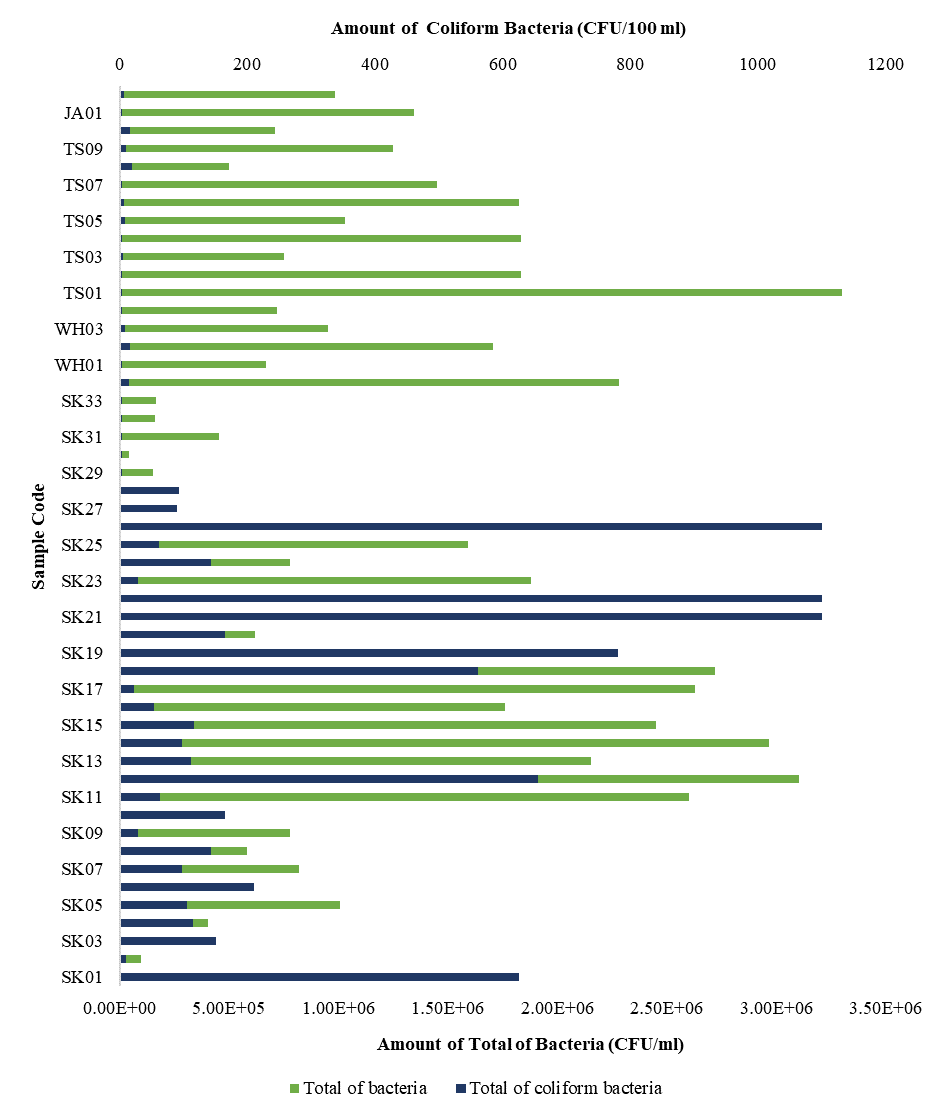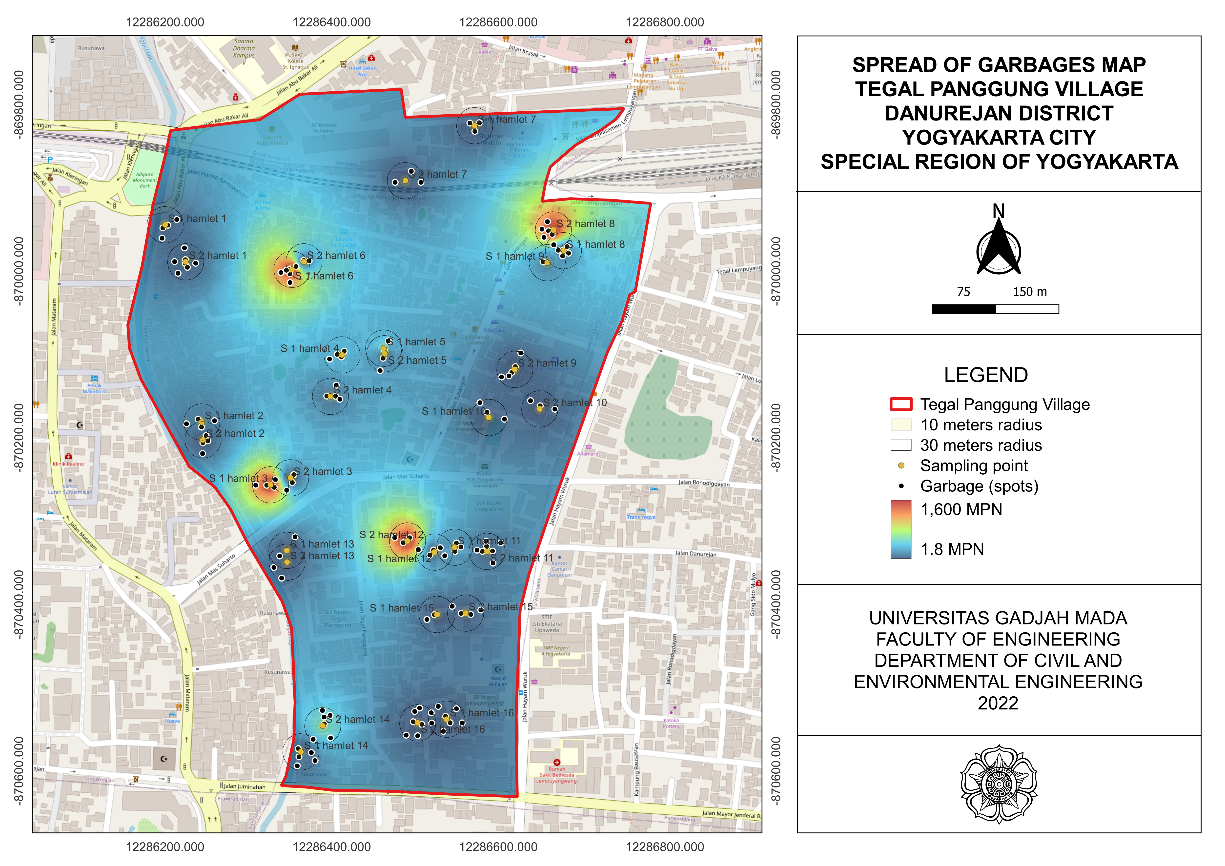Integrating Environmental Health into Disaster-Resilient Villages: Strategies, Challenges, and Solutions in Surakarta, Indonesia

Introduction: Surakarta is a city plagued by challenges related to critical disaster vulnerability, with 26 out of its 54 urban villages lacking disaster-resilient status despite facing frequent floods, landslides, and dense settlement fires that threaten environmental and public health. Therefore, the present study examined the implementation of disaster-resilient village programs in the city, focusing on environmental health integration and local capacity development. Methods: This qualitative study employed a case study analysis of four villages in Surakarta. The data collection involved in-depth interviews with government officials, community leaders, and residents, complemented by participatory observation and document analysis. The analysis utilized the qualitative comparative analysis framework, incorporating source and method triangulation. Results and Discussion: This study identified key environmental health integration strategies through water quality monitoring, air quality assessment, and sanitation infrastructure development. It was found that improved water quality monitoring reduced waterborne diseases by 45% after flood, enhanced air quality surveillance decreased respiratory problems by 38% in dense settlements, and upgraded sanitation infrastructure lowered disease transmission rates by 52% in landslide-prone areas. Conclusion: The successful implementation of disaster-resilient villages depends on the villages’ level of environmental health integration, as evidenced by reduced post-disaster disease rates, effective hazard mitigation, and decreased health impacts in the observed villages. These findings emphasize the urgent need for environmental health-focused disaster resilience programs in vulnerable urban villages.
Senay E, Hantel A. Environmental Health: Translating Policy Into Action. Annals of Internal Medicine. 2022;175(11):1612–1613. https://doi.org/10.7326/M22-2808
Abbasi K, Ali P, Barbour V, Benfield T, Bibbins‐Domingo K, Hancocks S, et al. Time to Treat The Climate and Nature Crisis As One Indivisible Global Health Emergency. Journal of Small Animal Practice. 2024;65(2):87–89. https://doi.org/10.1111/jsap.13687
Zeng H, Gan H, Liu Y, Sun B. The Global Disease Burden Attributable To Unsafe Water, Sanitation, and Handwashing With Unqualified Facilities From 1990 to 2019. Journal of Global Health. 2024;14(1):1-9. https://doi.org/10.7189/jogh.14.04162
Charnley GEC, Kelman I, Gaythorpe KAM, Murray KA. Traits and Risk Factors For Postdisaster Infectious Disease Outbreaks: A Systematic Review. Scientific Reports. 2021;11(1):1-14. https://doi.org/10.7189/jogh.14.04162
Paton D, Johnston D. Disaster Resilience: An Integrated Approach. 3rd ed. Springfield: Charles C Thomas Publisher; 2023.
McLoughlin GM, Kumanyika S, Su Y, Brownson RC, Fisher JO, Emmons KM. Mending The Gap: Measurement Needs to Address Policy Implementation Through A Health Equity Lens. Translational Behavioral Medicine. 2024;14(4):207–214. https://doi.org/10.1093/tbm/ibae004
Béné C, Mehta L, McGranahan G, Cannon T, Gupte J, Tanner T. Resilience As A Policy Narrative: Potentials And Limits In The Context Of Urban Planning. Climate and Development. 2018;10(2):116–133. https://doi.org/10.1080/17565529.2017.1301868
Cartwright N. Scientific Models Versus Social Reality. Building Research & Information. 2016;44(3): 334–337. https://doi.org/10.1080/09613218.2015.1083811
Lassa JA, Boli Y, Nakmofa Y, Fanggidae S, Ofong A, Leonis H. Twenty Years of Community-Based Disaster Risk Reduction Experience from a Dryland Village in Indonesia. Jàmbá: Journal of Disaster Risk Studies. 2018;10(1):1-10. https://doi.org/10.4102/jamba.v10i1.502
Krogh AH, Røiseland A. Urban Governance of Disaster Response Capacity: Institutional Models of Local Scalability. J Homel Secur Emerg Mgmt. 2024;21(1):27–47. https://doi.org/10.1515/jhsem-2022-0005
Nopriyasman N, Asnan G, Fauzi A, Hastuti IP, Ritonga AH, Kurniawan V, et al. Reading Indigenous Signs: The Wisdom Of Nagari Communities Toward Natural Disaster in Pasaman Barat. International Journal of Disaster Risk Reduction. 2024;107(1):1-11. https://doi.org/10.1016/j.ijdrr.2024.104497
Sutley EJ. An Approach for Guiding the Development and Assessing the Interdisciplinarity of New Methodologies for Community Disaster Resilience. Risk Analysis. 2021;41(7):1066–1071. https://doi.org/10.1111/risa.13253
Yin RK. Case Study Research and Applications: Design and Methods. 6th ed. London: Sage Publications; 2018.
De Sisto M, Shearing C, Heffernan T, Sanderson D. Reshaping Disaster Management: An Integrated Community‐Led Approach. Australian Journal of Public Administration. 2024;1(1):1–28. https://doi.org/10.1111/1467-8500.12668
Djalante R, Shaw R, DeWit A. Building Resilience Against Biological Hazards and Pandemics: COVID-19 and Its Implications for The Sendai Framework. Progress in Disaster Science. 2020;6(1):1-7. https://doi.org/10.1016/j.pdisas.2020.100080
Orlando LF, DePinto AJ, Wallace KJ. Ecohealth Villages: A Framework for an Ecosystem Approach to Health In Human Settlements. Sustainability. 2022;14(12):1-11. https://doi.org/10.3390/su14127053
Lu Y, Wang Y, Zhan C. Building Rural Community Disaster Resilience in Developing Countries: Insights from a Chinese NGO’s Safe Rural Community Programme. Disasters. 2023;47(4):1090–1117. https://doi.org/10.1111/disa.12586
Few R, Ramírez V, Armijos MT, Hernández LAZ, Marsh H. Moving with Risk: Forced Displacement and Vulnerability To Hazards in Colombia. World Development. 2021;144(1):1-12. https://doi.org/10.1016/j.worlddev.2021.105482
National Agency for Disaster Countermasure. Data and Information of Indonesian’s Disaster (DIBI). Jakarta: National Agency for Disaster Countermasure; 2023. https://bnpb.go.id
Djalante R, Garschagen M. A Review of Disaster Trend and Disaster Risk Governance in Indonesia: 1900–2015. Disaster Risk Reduction. 2017:21–56. https://doi.org/10.1007/978-3-319-54466-3_2
Ma C, Qirui C, Lv Y. “One Community At A Time”: Promoting Community Resilience in the Face of Natural Hazards and Public Health Challenges. BMC Public Health. 2023;23(1):1-15. https://doi.org/10.1186/s12889-023-17458-x
Hao Z, Lun Y. Using Traditional Knowledge To Reduce Disaster Risk: A Case of Tibetans in Deqen County, Yunnan Province. International Journal of Disaster Risk Reduction. 2024;108(1):1-21. https://doi.org/10.1016/j.ijdrr.2024.104492
Toyoda Y, Tanwattana P. Extracting Local Disaster Knowledge Through Gamification in a Flood Management Model Community in Thailand. Progress in Disaster Science. 2023;20(1):1-20. https://doi.org/10.1016/j.pdisas.2023.100294
McEwen L, Holmes A, Quinn N, Cobbing P. ‘Learning for Resilience’: Developing Community Capital Through Flood Action Groups In Urban Flood Risk Settings With Lower Social Capital. International Journal of Disaster Risk Reduction. 2018;27(1):329–342. https://doi.org/10.1016/j.ijdrr.2017.10.018
Hadlos A, Opdyke A, Hadigheh SA. Where Does Local and Indigenous Knowledge in Disaster Risk Reduction Go From Here? A Systematic Literature Review. International Journal of Disaster Risk Reduction. 2022;79(1):1-19. https://doi.org/10.1016/j.ijdrr.2022.103160
McWilliam A, Wasson RJ, Rouwenhorst J, Amaral AL. Disaster Risk Reduction, Modern Science and Local Knowledge: Perspectives from Timor-Leste. International Journal of Disaster Risk Reduction. 2020;50(1):1-10. https://doi.org/10.1016/j.ijdrr.2020.101641
Su H, Zhao X, Wang L, Li Y. How Rural Community Resilience Evolves After A Disaster? A Case Study of The Eastern Qinghai-Tibetan Plateau, China. Applied Geography. 2024;165(1):1-13 https://doi.org/10.1016/j.apgeog.2024.103238
Akthar TM, Reid MJA. The Urgency of Climate-Resilient Health Systems in Pakistan: Lessons from The 2022 Floods. International Journal of Public Health. 2024;69(1):1–2. https://doi.org/10.3389/ijph.2024.1607981
La JJ, Li M, Liu X. The Application of Innovative Ecosystems to Build Resilient Communities in Response to Major Public Health Events. Frontiers in Public Health. 2024;12(1):1–15. https://doi.org/10.3389/fpubh.2024.1348718
Abbasi K, Ali P, Barbour V, Benfield T, Bibbins‐Domingo K, Hancocks S, et al. Time to Treat the Climate and Nature Crisis As One Indivisible Global Health Emergency. Medical Journal of Australia. 2023;219(11):530–532. https://doi.org/10.5694/mja2.52148
Bakolis I, Barratt A, Canning T, Haddock R, Harding S, Hunter A, et al. Climate Emergencies and Health System Resilience Collaborative Research Action (CHESS): Challenges and Best Practice from the UK and Australia. ISEE Conference Abstracts. 2022;2022(1). https://doi.org/10.1289/isee.2022.P-0589
Pagliarin S, La Mendola S, Vis B. The “Qualitative” In Qualitative Comparative Analysis (QCA): Research Moves, Case-Intimacy and Face-To-Face Interviews. Quality & Quantity. 2023;57(1):489–507. https://doi.org/10.1007/s11135-022-01358-0
Erickson TB, Brooks J, Nilles EJ, Pham PN, Vinck P. Environmental Health Effects Attributed to Toxic and Infectious Agents Following Hurricanes, Cyclones, Flash Floods and Major Hydrometeorological Events. Journal of Toxicology and Environmental Health, Part B. 2019;22(5–6):157–171. https://doi.org/10.1080/10937404.2019.1654422
World Health Organization. Operational Framework for Building Climate Resilient Health Systems. Geneva: World Health Organization; 2015. https://iris.who.int/handle/10665/189951
Sánchez Gonzales HM, Sánchez González M, Martos Moreno J. The Methodology Used by Fact-Checkers. An In-Depth Analysis of Commonly Used Strategies. Journalism Practice. 2024;1–24. https://doi.org/10.1080/17512786.2024.2340522
Tashiro A. Assessing Green Management in Health Belief Model: An Analysis of A Postdisaster Rural Context. Journal of Environmental Management. 2022;302(A):1-9. https://doi.org/10.1016/j.jenvman.2021.114025
Wilson MJ, Aw TG, Sherchan S, Wickliffe J, Murphy SA. The Environmental Health and Emergency Preparedness Impacts of Hurricane Katrina. American Journal of Public Health. 2020;110(10):1476–1477. https://doi.org/10.2105/AJPH.2020.305819
Adie BA. Place attachment And Postdisaster Decision-Making in a Second Home Context: A Conceptual Framework. Current Issues in Tourism. 2020;23(10):1205–1215. https://doi.org/10.1080/13683500.2019.1600475
Wang S, Richardson MB, Evans MB, Johnson E, Threadgill-Matthews S, Tyson S, et al. A Community-Engaged Approach to Understanding Environmental Health Concerns and Solutions in Urban and Rural Communities. BMC Public Health. 2021;21(1):1-15. https://doi.org/10.1186/s12889-021-11799-1
Sprague Martinez L, Ginzburg SL, Ron S, Brinkerhoff CA, Haque S, England SA, et al. Communities Catalyzing Change with Data to Mitigate an Invisible Menace, Traffic-Related Air Pollution. BMC Public Health. 2024;24(1):1-16. https://doi.org/10.1186/s12889-024-17864-9
Alamo-Hernández U, Espinosa-García AC, Rangel-Flores H, Farías P, Hernández-Bonilla D, Cortez-Lugo M, et al. Environmental Health Promotion of a Contaminated Site in Mexico. EcoHealth. 2019;16(2):317–329. https://doi.org/10.1007/s10393-019-01407-5
Muhamad Khair NK, Lee KE, Mokhtar M. Community-Based Monitoring for Environmental Sustainability: A Review of Characteristics and The Synthesis of Criteria. Journal of Environmental Management. 2021;289(1):1-13. https://doi.org/10.1016/j.jenvman.2021.112491
Rawat A, Witt E, Roumyeh M, Lill I. Advanced Digital Technologies in the Postdisaster Reconstruction Process: A Review Leveraging Small Language Models. Buildings. 2024;14(11):1-35. https://doi.org/10.3390/buildings14113367
Girotto CD, Piadeh F, Bkhtiari V, Behzadian K, Chen AS, Campos LC, et al. A Critical Review of Digital Technology Innovations for Early Warning of Water-Related Disease Outbreaks Associated with Climatic Hazards. International Journal of Disaster Risk Reduction. 2024;100(1):1-16. https://doi.org/10.1016/j.ijdrr.2023.104151
Sullivan D, Schmitt HJ, Calloway EE, Clausen W, Tucker P, Rayman J, et al. Chronic Environmental Contamination: A Narrative Review of Psychosocial Health Consequences, Risk Factors, and Pathways to Community Resilience. Social Science & Medicine. 2021;276(1):1-17. https://doi.org/10.1016/j.socscimed.2021.113877
Reams MA, Irving JK. Applying Community Resilience Theory to Engagement with Residents Facing Cumulative Environmental Exposure Risks: Lessons From Louisiana’s Industrial Corridor. Reviews on Environmental Health. 2019;34(3):235–244. https://doi.org/10.1515/reveh-2019-0022
Dewa O, Makoka D, Ayo‐Yusuf OA. Measuring Community Flood Resilience and Associated Factors in Rural Malawi. Journal of Flood Risk Management. 2023;16(1):1-21. https://doi.org/10.1111/jfr3.12874
Afkhamiaghda M, Elwakil E. Challenges Review of Decision Making In Postdisaster Construction. International Journal of Construction Management. 2023;23(14):2409–2418. https://doi.org/10.1080/15623599.2022.2061751
Zhao L, He F, Zhao C. A framework of Resilience Development for Poor Villages After the Wenchuan Earthquake Based on the Principle of “Build Back Better”. Sustainability. 2020;12(12):1-25. https://doi.org/10.3390/su12124979
Gaillard JC, Cadag JRD, Rampengan MMF. People’s Capacities in Facing Hazards and Disasters: An overview. Natural Hazards. 2019;95(3):863–876. https://doi.org/10.1007/s11069-018-3519-1
Pelling M, Chow WTL, Chu E, Dawson R, Dodman D, Fraser A, et al. A Climate Resilience Research Renewal Agenda: Learning Lessons from The COVID-19 Pandemic For Urban Climate Resilience. Climate and Development. 2022;14(7):617–624. https://doi.org/10.1080/17565529.2021.1956411
Dazzi S, Vacondio R, Mignosa P, Aureli F. Assessment of Presimulated Scenarios as a Nonstructural Measure for Flood Management in Case of Levee-Breach Inundations. International Journal of Disaster Risk Reduction. 2022;74(1):1-16. https://doi.org/10.1016/j.ijdrr.2022.102926
Crawford K, Finn M. The Limits of Crisis Data: Analytical And Ethical Challenges of Using Social and Mobile Data to Understand Disasters. GeoJournal. 2015;80(4):491–502. https://doi.org/10.1007/s10708-014-9597-z
Ghaffarian S, Taghikhah FR, Maier HR. Explainable Artificial Intelligence in Disaster Risk Management: Achievements and Prospective Futures. International Journal of Disaster Risk Reduction. 2023;98(1):1-22. https://doi.org/10.1016/j.ijdrr.2023.104123
Kaganzi KR, Cuni-Sanchez A, Mcharazo F, Martin EH, Marchant RA, Thorn JPR. Local Perceptions of Climate Change and Adaptation Responses from Two Mountain Regions in Tanzania. Land. 2021;10(10):1-22. https://doi.org/10.3390/land10100999
Cutter SL. The Changing Nature of Hazard and Disaster Risk in the Anthropocene. Annals of the American Association of Geographers. 2021;111(3):819–827. https://doi.org/10.1080/24694452.2020.1744423
Subba R. Monitoring Marine Oxygen with Pores in Benthic Foraminifera. Nature Reviews Earth & Environment. 2023;4(7):248-249. https://doi.org/10.1038/s43017-023-00412-1
Folke C, Polasky S, Rockström J, Galaz V, Westley F, Lamont M, et al. Our Future in the Anthropocene Biosphere. Ambio. 2021;50(4):834–869. https://doi.org/10.1007/s13280-021-01544-8
Liu BF, Iles IA, Herovic E. Leadership Under Fire: How Governments Manage Crisis Communication. New York: New York University Press; 2022.
Blaikie P, Cannon T, Davis I, Wisner B. At Risk: Natural Hazards, People’s Vulnerability and Disasters. London: Routledge; 2014. https://doi.org/10.4324/9780203714775
Banerjee I, Warnier M, Brazier FMT. Designing Inclusion and Continuity for Resilient Communication During Disasters. Sustainable and Resilient Infrastructure. 2022;7(6):955–970. https://doi.org/10.1080/23789689.2022.2124717
Sun J, Stephens KK, Tasuji T, Faust K, Castellanos S. Community Resilience in A Cascading Disaster: Enacting A Hybrid Hyperlocal Community Of Practices (HCoPs) Through Online/Offline Communication. Journal of Applied Communication Research. 2024;52(3):318–337. https://doi.org/10.1080/00909882.2024.2341082
Arora M. Environment and Human Health as Complex Interacting Systems. BioEssays. 2021;43(9):1–2. https://doi.org/10.1002/bies.202100177
Adebayo WG. Resilience in the Face of Ecological Challenges: Strategies for Integrating Environmental Considerations Into Social Policy Planning in Africa. Sustainable Development. 2024;2024(1)1–18. https://doi.org/10.1002/sd.3113

This work is licensed under a Creative Commons Attribution-NonCommercial-ShareAlike 4.0 International License.
1. Copyright of all journal manuscripts is held by the Jurnal Kesehatan Lingkungan.2. Formal legal provisions to access digital articles of electronic journal are subject to the provision of the Creative Commons Attribution-ShareAlike license (CC BY-NC-SA), which means that Jurnal Kesehatan Lingkungan is rightful to keep, transfer media/format, manage in the form of databases, maintain, and publish articles.
3. Published manuscripts both printed and electronic are open access for educational, research, and library purposes. Additionally, the editorial board is not responsible for any violations of copyright law.
JKESLING by UNAIR is licensed under a Creative Commons Attribution-ShareAlike 4.0 International License.







































